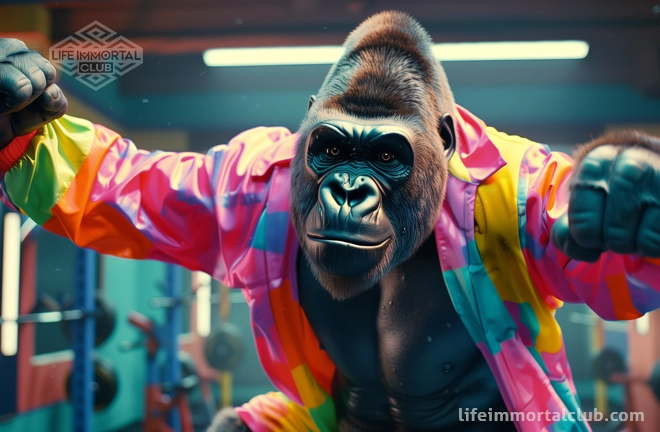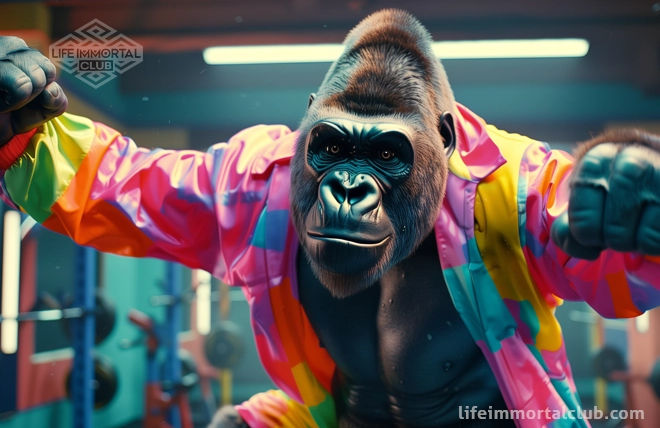Gorilla Walk : It A Crazy Exercise Worth Looking Into?

There was a time, in the early 2000s, dance floors and studios across the globe witnessed a peculiar craze that had everyone talking - "The Gorilla Dance." Partygoers and dancers alike threw their arms and legs about, channeling their inner primates in a dance phenomenon that swept the world. It was a sight to behold, with moves that, while fun, bordered on the bizarre.
Fast forward 20 years, and what once seemed like a mere fad has evolved into something unexpectedly influential. The "Gorilla Walk" has emerged, not as a dance routine, but as a groundbreaking exercise trend. Mimicking the movements of our primate cousins, enthusiasts are engaging their body's major muscle groups in ways that transcend traditional workouts.
It turns out, the seemingly zany choreography of "The Gorilla Dance" was ahead of its time, laying the groundwork for a fitness revolution that makes embracing our ancestral roots not just fun, but beneficial for our health.
Gorilla Walking, a Playful Yet Effective Exercise
Gorilla Walking has recently gained traction in gymnastics, calisthenics, and animal flow workouts, often featured in warm-ups. This full-body activity, mimicking the locomotion of gorillas, engages multiple muscle groups in a way daily routines seldom do.
From my experience, despite its initial oddity, the benefits were immediate. The primate-inspired movements significantly enhance mobility across hips, shoulders, and wrists, while strenuously working the core and other major muscles. Committing to this exercise for a week, I personally felt more flexibility in my hips and hamstrings.
Gorilla Walk: A Nod to Our Ancestral Past
Humans, primarily bipedal for millions of years, have evolved to cover vast distances, adapt to various habitats, and survive challenging conditions through upright walking. Yet, our ancestors once moved on all fours, akin to monkeys or gorillas. Embracing this ancient form of movement today can bolster strength and mobility without relying on equipment or weights. It's a throwback that challenges our coordination and strength by engaging all four limbs in a unique, compound movement rarely replicated in modern workouts.
Dr. Santiago Kweitel, a renowned sports medicine doctor and director at Favaloro University, sheds light on this intriguing practice. According to him, the Gorilla Walk is not just a novel exercise but a holistic activity brimming with benefits for our body's balance, coordination, and mobility.
Delving deeper, enthusiasts who've incorporated this walk into their daily routines rave about its remarkable impacts:
- Enhanced Balance and Coordination: Navigating the world on all fours isn't typical for humans, requiring an exceptional level of coordination to sync our arms and legs. This act of balancing, much like our ape cousins, significantly improves our stability.
- Boosted Hip Mobility: In an age dominated by sedentary lifestyles, our hips often suffer from lack of movement. The Gorilla Walk breathes life into our hips, engaging them in a variety of movements that stretch and strengthen these crucial joints.
- Stronger Shoulders and Wrists: Mimicking the powerful, muscular arms of gorillas, this exercise puts our upper body to work in ways we rarely experience, enhancing the strength and flexibility of our shoulders and wrists.
With the Gorilla Walk gaining traction, Dr. Kweitel recommends incorporating it into your workout as a preliminary warm-up or muscle activation exercise, rather than the main element of your fitness regime. He believes this method effectively prepares the body for more demanding exercises, contributing to a comprehensive workout plan. Therefore, the next time you prepare for a workout, consider embracing the Gorilla Walk to kickstart a vigorous and productive training session.
Here's how to master the Gorilla Walk:
- Start Position: Begin in a deep squat, heels down, slightly wider than your shoulders, aligning your knees with your big toes. Keep your spine straight to engage your core without slouching.
- Movement: Gently shift your weight from side to side, letting your arms hang but maintaining your shoulders back. Place your hands in front of you, using your core to power the movement.
- Legs and Direction: Your legs should synchronize with the movements of your torso and arms. Try moving in one direction first, then switch to go the opposite way for balance.
- Caution and Consultation: Despite its benefits, this exercise might not be suitable for everyone, particularly those with ankle, knee, or hip injuries. Dr. Kweitel stresses the importance of consulting a doctor to evaluate your specific situation and approve the exercise.
This technique, when executed correctly and safely, can enhance your workout routine with its dynamic and engaging movements. Integrating the "Gorilla Walk" into your regular fitness routine offers more than just an innovative way to exercise; it holds the promise of a healthier, potentially longer life. By engaging in this dynamic workout, you not only challenge your body in new and beneficial ways but also tap into deep-rooted physiological benefits that can enhance your overall well-being. Over time, the strength, balance, and flexibility gained from mimicking these primal movements could significantly contribute to improved health and longevity. Embracing the Gorilla Walk is not just about embracing a workout trend; it's about taking a step towards a more vibrant and enduring life.





